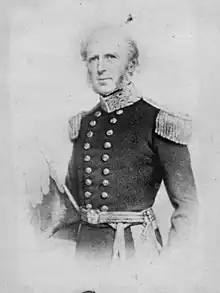| Defunct pre-Confederation electoral district | |
|---|---|
| Legislature | Legislative Assembly of the Province of Canada |
| District created | 1841 |
| District abolished | 1867 |
| First contested | 1841 |
| Last contested | 1863 |
Megantick (French: Mégantic) was an electoral district of the Legislative Assembly of the Parliament of the Province of Canada, in Canada East, in the Eastern Townships. It was created in 1841 and was based on the previous electoral district of the same name for the Legislative Assembly of Lower Canada. It was represented by one member in the Legislative Assembly.
The electoral district was abolished in 1867, upon the creation of Canada and the province of Quebec.
Boundaries
The Union Act, 1840 merged the two provinces of Upper Canada and Lower Canada into the Province of Canada, with a single Parliament. The separate parliaments of Lower Canada and Upper Canada were abolished.[1]
The Union Act provided that the pre-existing electoral boundaries of Lower Canada and Upper Canada would continue to be used in the new Parliament, unless altered by the Union Act itself.[2] The Megantick electoral district of Lower Canada was not altered by the Act, and therefore continued with the same boundaries which had been set by a statute of Lower Canada in 1829:
The electoral district of Megantick was located in the Eastern Townships (now the Estrie and Chaudière-Appalaches regions).
Members of the Legislative Assembly
Megantick was a single-member constituency.[4]
The following were the members of the Legislative Assembly from Megantick. "Party" was a fluid concept, especially during the early years of the Province of Canada. Party affiliations are based on the biographies of individual members given by the National Assembly of Quebec, as well as votes in the Legislative Assembly.[5][6][7]
| Parliament | Member | Years in Office | Party | |
|---|---|---|---|---|
| 1st Parliament 1841–1844 |
Dominick Daly |  |
1841–1848 | Unionist; Government supporter; "British" Tory |
| 2nd Parliament 1844–1848 |
"British" Tory | |||
| 3rd Parliament 1848–1851 |
Dominick Daly[lower-alpha 1] |  |
1848–1849 | "British" Tory |
| Dunbar Ross[lower-alpha 2] | 1850–1851 | Ministerialist | ||
Notes
- ↑ Seat became vacant on Daly accepting appointment to a commission in England, 1849: Côté, Political Appointments and Elections, p. 61, note (105).
- ↑ Elected in by-election, May 1, 1850: Côté, Political Appointments and Elections, p. 61, note (106).
Abolition
The district was abolished on July 1, 1867, when the British North America Act, 1867 came into force, splitting the Province of Canada into Quebec and Ontario.[8] It was succeeded by electoral districts of the same name in the House of Commons of Canada[9] and the Legislative Assembly of Quebec.[10]
References
- ↑ Union Act, 1840, 3 & 4 Vict., c. 35, s. 2.
- ↑ Union Act, 1840, ss. 16, 18.
- ↑ An Act to make a new and more convenient subdivision of the Province into Counties, for the purpose of effecting a more equal Representation thereof in the Assembly than heretofore, SLC 1829, c. 73, s. 1, para. 9.
- ↑ Union Act, 1840, s. 18.
- ↑ J.O. Côté, Political Appointments and Elections in the Province of Canada, 1841 to 1860 (Quebec: St. Michel and Darveau, 1860), pp. 43–58.
- ↑ Québec Dictionary of Parliamentary Biography, from 1764 to the present.
- ↑ Paul G. Cornell, Alignment of Political Groups in Canada, 1841–67 (Toronto: University of Toronto Press, 1962; reprinted in paperback 2015), pp. 93–111.
- ↑ British North America Act, 1867 [now the Constitution Act, 1867, s. 6.
- ↑ Constitution Act, 1867, s. 40, para. 2
- ↑ Constitution Act, 1867, s. 80.
![]() This article incorporates text from this source, which is in the public domain: Statutes of Lower Canada, 13th Provincial Parliament, 2nd Session (1829), c. 74
This article incorporates text from this source, which is in the public domain: Statutes of Lower Canada, 13th Provincial Parliament, 2nd Session (1829), c. 74